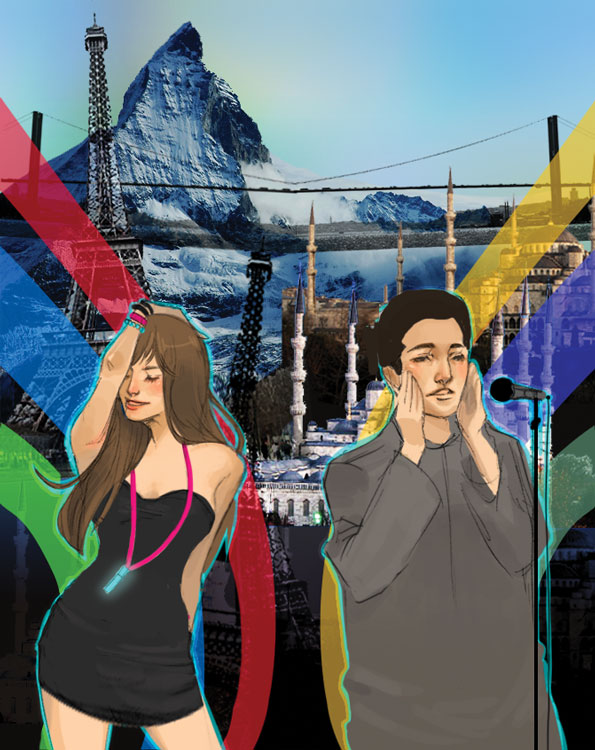Many Bruins who have traveled abroad have found that the music of Western Europe is a true looking glass into the polarized cultures of the region. This range extends from electro-pop discotheques, to underground death metal to the local music scene, the last striving for notoriety in the midst of the former two.
Cohesive with the stereotypical perspective of a rave-savvy, electronically drenched European atmosphere, an upbeat club vibe seemed to permeate the local music scene in Paris and other cultural hubs of the continent.
“A lot of French teenagers like hip-hop, but a lot of what I heard was a sort of techno-pop infusion, all in French.” said third-year English and French student Anthony Zarate, who participated in the advanced French travel study program in Paris. “It’s having fun kind of music, very lively and energetic stuff made for the bars and discotheques. It makes you want to get up and dance to it.”
A few artists in particular stood out in the sea of pop electronica, including Christophe Willem, whose style is comprised of a pop foundation with bass and guitar riffs, and electronic dance diva Yelle.
“Yelle was all over the club scene,” said UCLA student Anna Miller, who also participated in the Paris travel study program. “She reminds me a lot of Lady Gaga in some ways; the message conveyed isn’t complicated ““ just feel good and dance.”
Miller also unearthed a number of international dance favorites while perusing local bars and clubs throughout Paris ““ the French-Angolan King Kuduro, Congo natives Bisso Na Bisso and French-Arab rappers Maghreb United.
The Angolan Kuduro genre surfaced when the notion occurred to producers in Angola to mix African drum samples with simplistic Calypso rhythms.
Kuduro is composed of European and American electronic influences and also includes a mixture of house, hip-hop and reggae elements.
Not only did UCLA students find varied, culturally diverse strains of dance-pop-electronica, but they also found a generous heavy metal culture.
“I can tell you that Switzerland and a lot of Western Europe has a lot of house music going on, which isn’t really my thing,” said Daniel Whitehead, a UCLA alumnus who participated in travel study programs in Greece and Switzerland. “I was at a train station in Greece, and I saw a whole bunch of people dressed the way I did ““ basically in all black, with long hair. There was a metal show somewhere nearby, without a doubt.”
Parceling out time for a trip through Scandinavia was also an important component to Whitehead’s agenda; the region is a globally recognized haven for death metal bands.
Some bands that Whitehead pursued while in the area include Children of Bodom, The Haunted and Agnostic Front ““ all hard metal groups.
Whitehead trekked through Switzerland and Scandinavia with metal in mind, arriving back in the States with tales of an underground culture completely foreign to Paris’s electropop preoccupation ““ one involving a lot of moshing.
“I wasn’t able to attend Whacken, which would have been great. … It’s a big circuit of open-air metal festivals in Scandinavia where you basically pay to listen and mosh,” Whitehead said. “Scandinavia is predominantly a metal area, and most of the death metal in (America) today comes from there. A lot of the bands I listen to are actually played in the clubs. … The metal scene in Europe is a very underground thing.”
Switzerland also has a lot of smaller, more traditional festivals featuring residential rock and jazz groups. These concerts are much more intimate events that serve to elevate the status of the local culture.
Despite the efforts of these local events, the musical atmosphere in Switzerland is nonetheless heavily dominated by the larger surrounding countries of Western Europe.
“I went to a village festival with a lot of different local music held in the mountains,” said fourth-year business economics student Yanick Alder. “It’s a small country and there are so many foreigners, so a lot of the music comes from other places.”
A frequent visitor to Switzerland for the purpose of familial meetings, Alder is a veteran of such shows.
“The band playing when we got there this summer was playing a sort of reggae. … They were singing in English, but they were definitely from the area (in Switzerland). They were basically hillbillies singing reggae with a really horrible accent,” Alder said.
The Swiss don’t actually listen to their yodeling brethren every day. Except for national holidays, the Swiss citizens that aren’t already moshing and head-banging can be found at concerts of this sort that feature cover bands and local groups.
While studying in Germany through the language and culture education abroad program at the University of Potsdam, fourth-year chemistry student Fornia Ung witnessed an interesting spectrum of musical trends ranging from outdated American pop to new-wave instrumental dance music that originated in Germany.
“This guy named Peter Fox is really big there,” Ung said. “His style is hard to pin down ““ it’s a combination of a bunch of instruments you wouldn’t think would work together, yet it’s total dance music, very high energy.”
Peter Fox’s most popular track, “Alles Neu,” is an upbeat German pseudo-rap complete with a sizeable violin section and a drum line that establish the driving beat.
“Berlin is a major international musical and cultural hub,” said fourth-year global studies student Drew Otto, who participated in a German language immersion program in Berlin.
“After coming back from Berlin, a lot of the music I listen to now is more digital,” Otto said. “A lot of people in Berlin will ask, “˜Who’s your favorite DJ?’ rather than “˜Who’s your favorite band?’
“My idea of dance music has completely changed since I went to Berlin.”
